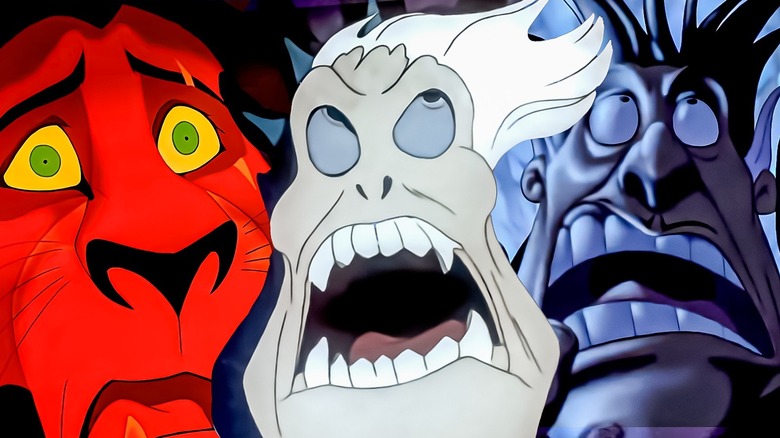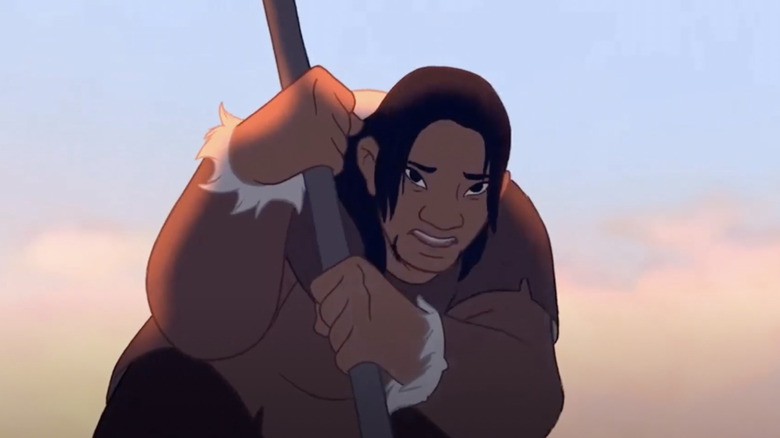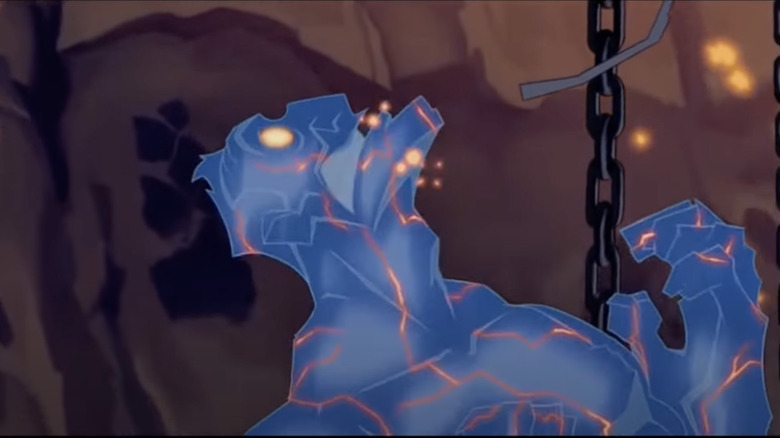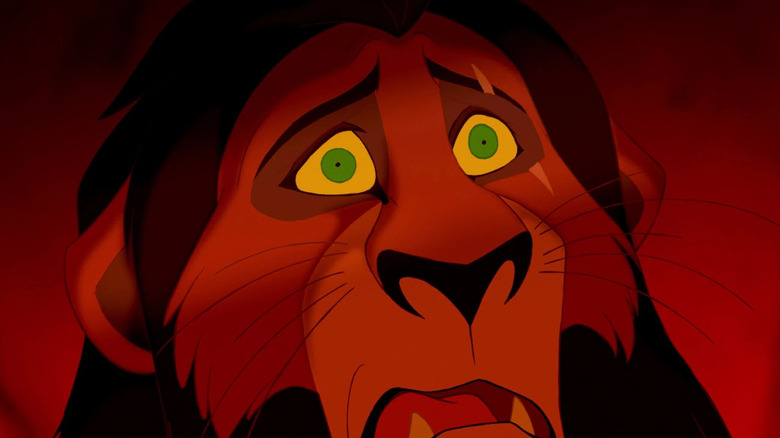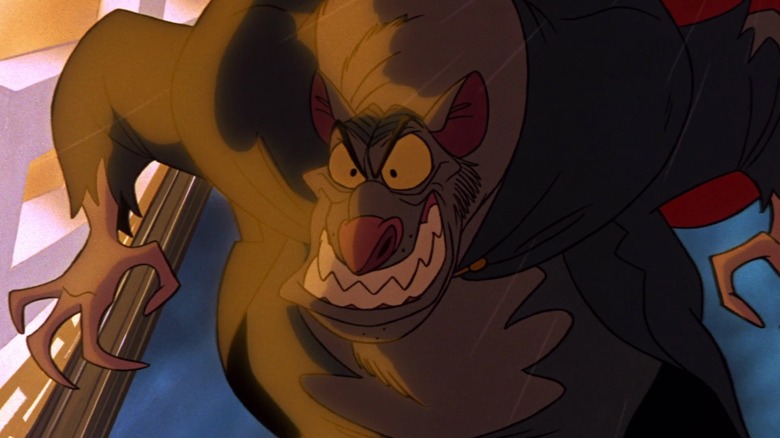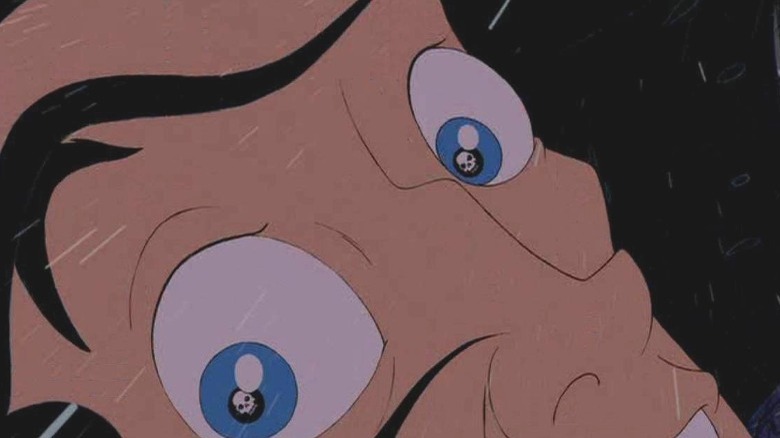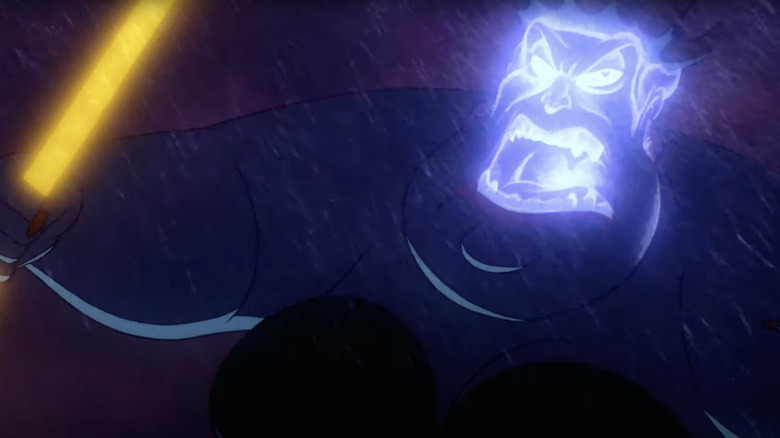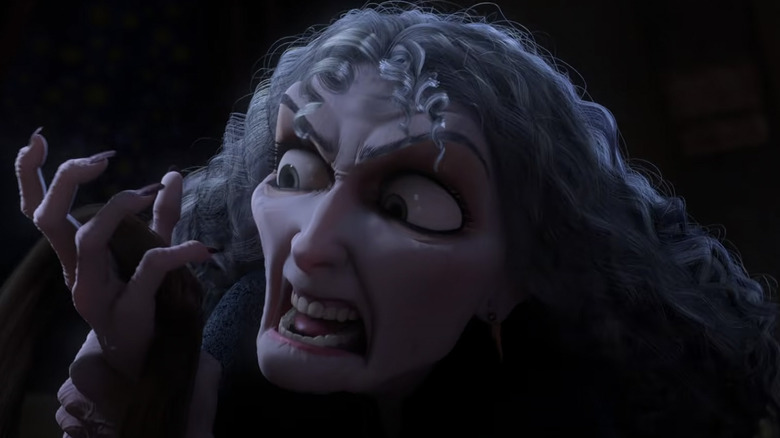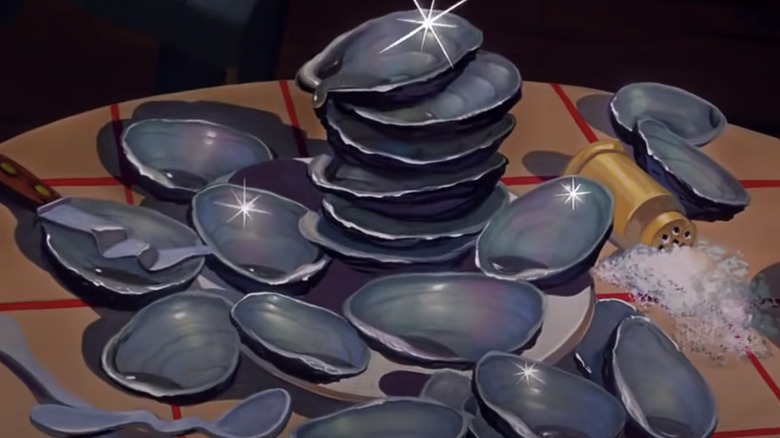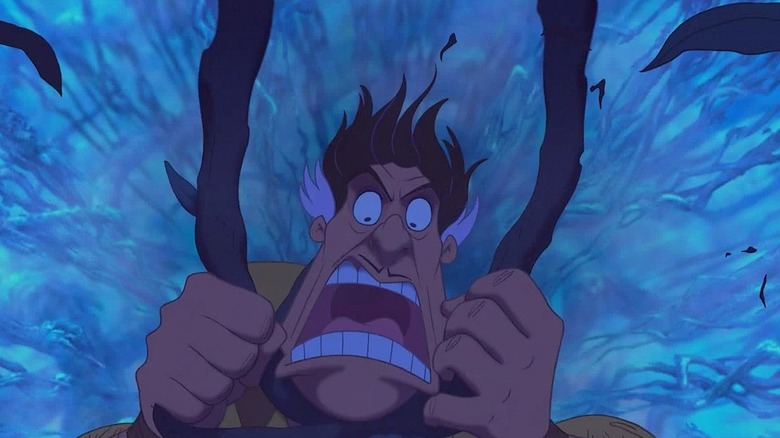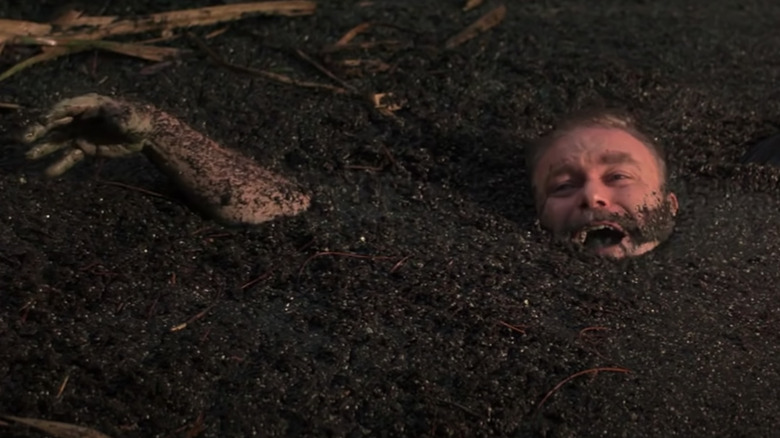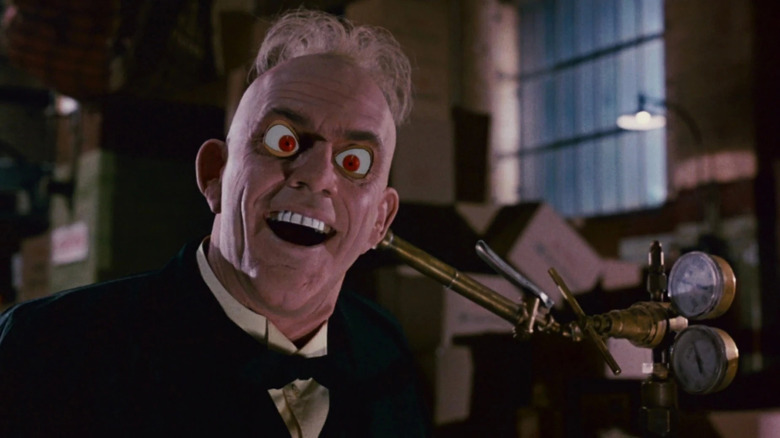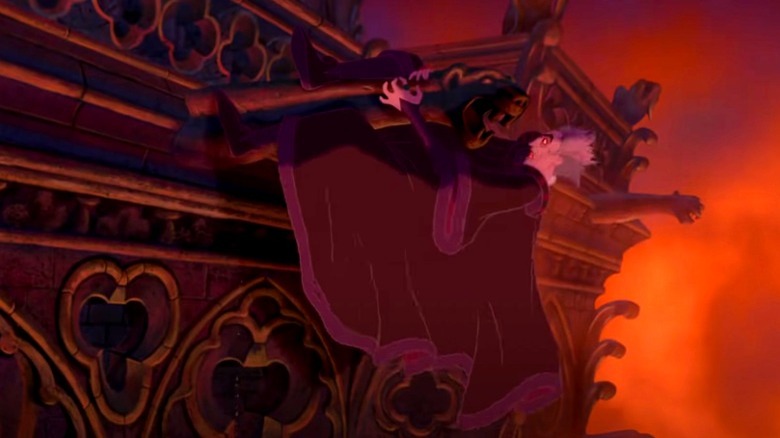The 12 Scariest Disney Death Scenes, Ranked
When people think of moments from Disney movies, they often focus on the sweeter examples. From Snow White dancing with Dopey to Jasmine and Aladdin discovering a whole new world, there's no shortage of adorable Disney scenes to choose from. Yet, as many Disney fans know, there's always been a darker side to the Mouse House's films. This comes through clearest in the studio's most frightening sequences, especially those that focus on the not-so-magical topic of death.
To some, the death of Bambi's mother remains a traumatic memory. For others, Mufasa's tragic demise in "The Lion King" left an inescapable mark on their youth. Whether they feature a dreadful antagonist's end or an adorable sidekick's demise, these moments deserve our admiration for giving us goosebumps well into our adult years. While we won't be focusing on any Pixar moments (since they deserve a spotlight of their own), there are plenty to pick from Disney's ever-growing film catalog. So, hold tight to your mouse ears, and let's examine Disney's spookiest takes on death.
Sitka's bear encounter — Brother Bear
In Disney's 2003 coming-of-age movie "Brother Bear," viewers initially follow the cozy-but-messy relationship between three Indigenous Alaskan brothers as they brave the beautiful but unpredictable post-Ice Age landscape. From awkward tribal ceremonies to challenging interactions with their siblings, the trio goes through the struggles typical of Disney families, with plenty of adolescent acceptance and other relatable growing pains. But everything changes once the eldest brother, Sitka (D.B. Sweeney), comes face-to-face with a giant bear, resulting in his untimely end.
While most Disney movies take place in fantasy settings, this sequence from "Brother Bear" is scary simply because bear attacks can and do happen in real life. The frantic filmmaking choices, like the quick cuts and aggressive close-ups, add to the scene's haunting quality and further amplify the battle's overall tension. However, it's the moment when Sitka slowly falls to his demise that really makes this death unsettling, especially when you realize it could have been avoided if his younger brother, Kenai (Joaquin Phoenix), had never interacted with the bear in the first place.
Rourke turns into a crystal — Atlantis: The Lost Empire
When fans discuss the best Disney villains, Commander Lyle Tiberius Rourke (James Garner) from "Atlantis: The Lost Empire" isn't mentioned nearly enough. But this manipulative baddie deserves more recognition, especially in regards to his horrific final scene. The moment in question occurs amid the chaotic third-act battle, in which Milo Thatch (Michael J. Fox) tries to stop Rourke from bringing Princess Kida (Cree Summer), who has become the avatar for Atlantis' ancient power source, to the surface. All seems to be going in Rourke's favor until a series of failures occurs, including Rourke transforming into a crystalized demonic being.
Given that Rourke initially seems like a controlled intellectual, it's only fitting that this unhinged, power-hungry antagonist becomes a genuine terror on the outside as much as he is on the inside. But the reason this moment is here isn't Rourke's transformation, but rather his frightful end — if turning into a monster and losing control of himself isn't terrible enough, his body eventually breaks into crystal shards, too. Ouch.
Scar's finale — The Lion King
Some of the best scenes are the ones that leave plenty of room for you to fill in the blanks. In Disney's 1994 masterpiece "The Lion King," for example, after the villainous lion Scar (Jeremy Irons) loses his battle with his nephew, he believes he's escaped unharmed. But once his hyena henchmen remind their boss how he publicly referred to his friends as "the enemy," Scar realizes his days are numbered.
Sure, this sequence may not be as directly gruesome as the in-your-face segments further down this list. But that's its strength; the brilliance of Scar's death lies in the artistic flourishes that excite the viewer's imagination. From the painful sound design to the evocative silhouettes, it's clear that the hyenas aren't just playing tag with Scar, but instead getting their bloodthirsty revenge. Of course, younger audience members might not get the complete picture of what's happening, but Disney's animators left enough clues for everyone else to fill in the gaps.
Ratigan's clock battle — The Great Mouse Detective
Throughout "The Great Mouse Detective," we only get glimpses of why the film's antagonist, Ratigan (Vincent Price), is a true physical threat. Then, near the end, the usually posh rat turns into a sinister creature (brilliantly designed by supervising animator Glen Keane) that proves how formidable he truly is. And while that transformation is daunting on its own, what makes Ratigan's death an obvious contender for this ranking comes down to the creative choices leading up to his (literal) downfall.
Right as Ratigan runs into the heroic Basil of Baker Street (Barrie Ingham) with Olivia (Susanne Pollatschek) under his arm, the flick's cozy atmosphere shifts towards a frantic, aggressive energy. It's a direction that perfectly mirrors Ratigan's Jekyll-to-Hyde-like transformation, making the finale feel like something akin to a Hitchcock thriller, especially as the camera follows Ratigan's chaotic, technically groundbreaking moves through Big Ben. Really, though, it's the expression on Ratigan's face right before he disappears into the London sky that gives this scene an unsettling edge that few humans — or rodents — will ever forget.
Gaston's death — Beauty and the Beast
When Disney's 1991 classic "Beauty and the Beast" reaches its heart-wrenching conclusion, Gaston (Richard White) and the Beast's (Robby Benson) initial roles flip. At first, viewers might think that Beast is the monster and Gaston is the hero. However, Gaston ultimately serves as the film's villain, with his traditional good looks and social charm failing to excuse his awful actions. From trying to lock up Maurice (Rex Everhart) so Belle (Paige O'Hara) will marry him to attacking Beast for petty reasons, Gaston deserves cinematic punishment for his crimes, and the movie delivers justice without batting a lash.Right from the get-go, Gaston's death is frightening because of its presentation.
In anyone else's hands, his demise could have come across like a scene from a sluggish Saturday morning cartoon. But, as handled by the talented artists of the Disney Renaissance era, the scene reveals both Gaston's vulnerability as he plummets down the side of the castle as well as — thanks to the blink-or-you'll-miss-them skulls in his eyes — the impending dread in the brute's soul. Ultimately, while this scene isn't as outlandish as others on this list, it earns its spot by being tremendously spooky.
Ursula's ship battle — The Little Mermaid
For fans of the Disney Renaissance, no villain is as fabulous and frightening as the sea witch Ursula from 1989's "The Little Mermaid." Voiced by the immortal Pat Carroll, this Divine-inspired character is often remembered for her sassy dialog and show-stopping song, "Poor Unfortunate Souls." That said, the moment that really cements her cinematic legacy is when she perishes in a most haunting fashion.
In a fit of anger, Ursula uses Triton's scepter to become a kaiju-sized sea monster in order to kill Ariel (Jodi Benson) and Prince Eric (Christopher Daniel Barnes). However, once Eric gets control of his ship, he stabs Ursula in her side, resulting in an immensely painful-looking death. Yet, the scariest aspect of this scene isn't the method by which Ursula dies, but rather the tiny details the animators include as she fades away. From the electricity pulsing through Ursula's skeleton to the bits of the sorcerer's body floating in the water, this scene remains pure nightmare fuel from start to finish.
Mother Gothel's transformation — Tangled
If we're talking about raven-haired beauties with Regina George vibes, Mother Gothel from 2010's "Tangled" (Broadway veteran Donna Murphy) must be part of the discussion. Not only is Gothel the very definition of an egotist, but she's also a master manipulator who will do anything to stay young and beautiful — even kidnapping a royal baby and locking her away for 18 years. It only makes sense, then, that a dramatic antagonist like Gothel gets a death scene that befits her over-the-top manner.
As soon as the heroic Flynn Rider (Zachary Levi) cuts Rapunzel's (Mandy Moore) hair, her long locks' magic disappears, and Gothel loses her "everlasting" beauty. But rather than making her age gracefully, the animators turn back the clock on Gothel with such brutality that it's as if the sun's magic itself is enacting revenge for Rapunzel's mistreatment. That horror-like intensity, along with Gothel's transformation into dust, gives this sequence an unforgettably eerie quality, which is why it ranks quite high amongst the deadly (pun intended) competition.
The oysters and the Walrus — Alice in Wonderland
Though many of the scenes featured here come from Disney's more recent animated films, the original Golden, Silver, and Bronze Age movies also contain plenty of scary deaths. For instance, take the scene from Disney's 1951 retelling of "Alice in Wonderland" in which Tweedle Dee and Tweedle Dum (J. Pat O'Malley) recount the cautionary tale of the oysters. At first, this seems like a silly sequence that fits right in with the movie's colorful energy. However, as it plays out, it's quickly evident that this story doesn't have a happy ending.
Covered in concept artist Mary Blair's signature pastel shades, this moment ranks near the top of this list because its aesthetics are brilliantly juxtaposed with its darkly comedic, creepy atmosphere. From the oysters' adorable designs to the charming-yet-sinister way the Walrus (also O'Malley) draws his new friends away from the ocean, the scene carries an uneasy feeling that's hard to ignore. And yet, it's the look on the precious oysters' faces as they realize their mistake that makes this moment an 11 on the scary scale. When the audience sees the aftermath of the Walrus' trickery, it's impossible to not feel terrified.
Clayton's demise — Tarzan
In the final act of Disney's adaptation of "Tarzan," the titular hero (Tony Goldwyn) ascends a vine-covered tree to escape the evil William Cecil Clayton (Brian Blessed). But once Clayton catches up to Tarzan, the mustache-wearing baddie becomes entangled in the vines, hanging himself in the process. To some, this sequence might sound tame, especially when compared to the others we've discussed. However, if you look at the scene's distinctive visuals, you'll know why it ranks among the scariest of them all.
With a thrilling musical score by Mark Mancina and gorgeous rain and lightning, this moment is a masterclass in establishing suspense from the very beginning. Still, the scene's most impressive (and alarming) component is Clayton's ultimate end, thanks largely to the subtle but unnerving sound effects and the shadow of Clayton's body projected onto a neighboring tree. It's impossible to ignore this Disney death's hardcore nature, or how the shocked look in Tarzan's eyes makes it even more traumatizing.
Sgt. Harley's fall — The Jungle Book
You might be surprised to learn that, more than a decade before the debut of Jon Favreau's "The Jungle Book" remake, Disney made a different live-action adaptation of Rudyard Kipling's beloved story. This 1994 film is more like an action movie, with an adult Mowgli (Jason Scott Lee) trying to defend his jungle friends and hidden treasures from the greedy Captain William Boone (Cary Elwes). As the movie progresses, we also meet Boone's fellow soldiers, including Sergeant Harley (Ron Donachie), who encounters one of the ghastliest ends in any Disney movie.
Harley chases after Mowgli following the hero's escape from captivity, but as Harley dashes through the perilous jungle, he falls into quicksand. He slowly begins to sink to his doom as friend Lieutenant John Wilkins (Jason Flemyng) watches in horror. In the grand scheme of horrific movie deaths, this might seem forgettable. However, for '80s and '90s kids who grew up with "The Neverending Story" and other vicious family films, Harley's demise explains why so many viewers, this writer included, became claustrophobic in their older years.
Judge Doom's death — Who Framed Roger Rabbit?
On a list like this, it would be a sin to not mention Judge Doom's demise in Robert Zemeckis' "Who Framed Roger Rabbit?" Played by the masterful Christopher Lloyd, this despicable character is remembered by many viewers for his toon-killing substance, the Dip. He's even better known for his goosebump-inducing final moments. It's a sight that (unfortunately) needs to be seen to be believed.
Beginning with Doom's flattened body rising from the ground and his human eyes popping out of his head, this scene is all about the uncanny nature of the villain himself. It would be one thing if Lloyd played the character straight, but the combination of Doom's high-pitched voice and intense appearance makes him the embodiment of cinematic fear — and it's even worse after he melts to the floor in a poodle of his own Dip. In short, this scene is why many fully-grown adults still sleep with a nightlight on.
Frollo meets the flames of Hell —The Hunchback of Notre Dame
If you're looking for the scariest Disney death scene of all time, go deep into your childhood memories and pick the moment that impacted you more than any other. For this writer (and quite a few other people), the obvious choice is the on-screen passing of Judge Claude Frollo (Tony Jay) in Disney's "The Hunchback of Notre Dame." Some fans might scratch their heads, arguing that other scenes deserve the top spot more, but if you give it a chance, it's easy to see why this sequence is the epitome of Disney's scary excellence.
With spectacular Gothic cinematography and Alan Menken's epic music, Frollo's death scene stands out because of the way that every detail emphasizes the film's narrative intensity. Just look at the progression of Frollo's horrendous appearance throughout the sequence, especially after he reveals his murderous past to his adopted son, Quasimodo (Tom Hulce). The events on screen become even more disturbing when Frollo comes face-to-face with a demonic gargoyle that sends him to the flames of Hell, symbolizing his internal guilt. Simply put, Frollo's death ranks this high because of the beautiful brutality imparted by Disney's talented animators. It's all the proof you need that both animation and Disney need to be taken more seriously.
